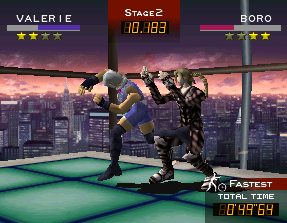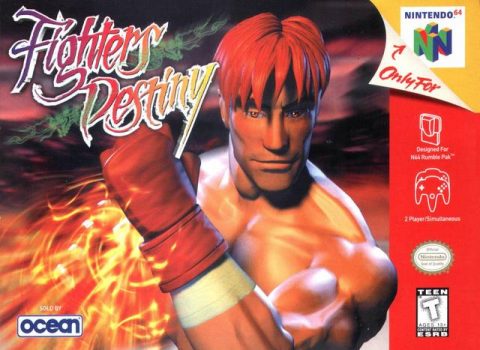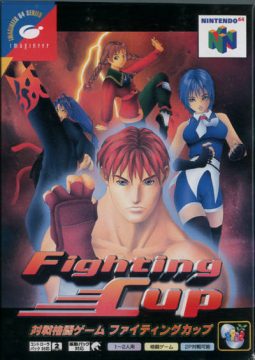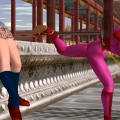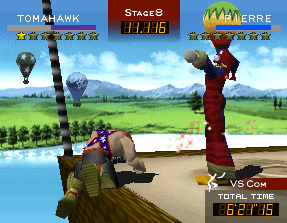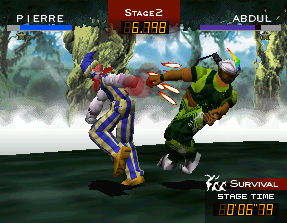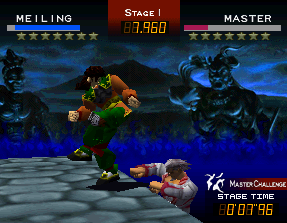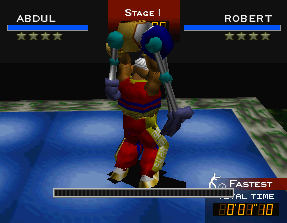- Fighters Destiny
- Fighter Destiny 2
Fighters Destiny was released in 1998 for the Nintendo 64, a system lacking in key genres such as fighters, shoot-em-ups and RPGs. FD still has one-on-one fights, with a timer, but almost every other convention was either abandoned or reworked. Even in early previews for N64 magazine, when the game was known as Struggle Hard, it showed promise because of its new points system. Instead of the first to two rounds set-up like other fighters, it was the first to earn a specific number of points, with points earned for performing a particular feat. A second preview again showed this as being first to 5 points, with 1 for a Ring Out, 2 for a Knockdown and 3 for a Special. By release this had been revised to 7 points. Players still had a health bar, like other fighters, but it was constantly recharging, which placed an emphasis on points. It was revolutionary (well, maybe it was a bit like Karate Champ, but still).
In both the first and second Fighter’s Destiny game there are six different ways to earn your 7 points and win the match. Each method earns a different amount. Instead of the rapid flow that can leave newcomers struggling against a veteran in a conventional fighter, FD is more methodical and all about timing. Once you’ve learned your character’s knockdown moves it’s quite possible to act cautiously and take down a well-practiced player. In this way FD keeps the playing field level and – therefore – a lot more fun. Button mashing won’t help and neither will memorizing complex strategies. Patience and consideration wins the match.
The genius of this system is that you can customize everything. The number of points needed can be set from 1 to 8. While everything from a Ring Out to finishing Specials can be set from 1 to 5. The arena size can also be set between 4 and 12 meters, just in case you wanted to emphasize Ring Outs. By tweaking the parameters you can create a completely different fighting game each time. There are only two attack buttons (upper and lower), plus block and a button for sideways evasive movement.
Ringout – 1 point
Simply push your opponent to the edge and out of the ring. Considering that other fighting games normally allot 1 of the needed 2 rounds for a Ring Out (50%), this rebalances everything by making it worth only 14% of the victory conditions. Be warned, an opponent can dangle on the edge of the arena and – if you go in for a low sweep – grab your leg for a throwdown move and 2 points.
Throw – 2 points
Pushing both upper and lower attack buttons activates either a standard throw or, if hanging from the arena’s edge, a throwdown – whereupon you grab your opponent and pull them down. During a normal throw a meter comes up, and if your opponent pushes down and both attack buttons they can cancel the throw and possibly even initiate one of their own – which you can also cancel if fast enough. However, when the opponent was blocking at the time a throw is initiated, it becomes impossible to cancel.
Knockdown – 3 points
This is where you’ll make most of your points. Each character has knockdown moves which act as instant kills. Activating them requires a slight charge time, telegraphed by a blue light from their hands, so opponents can either block or prepare to counter. But if you time it just as they’re coming out of a long attack animation, or a failed Knockdown themselves, you can easily land it. Using a knockdown it’s possible to finish a round in only a couple of seconds. Also if you reduce your opponent to the stunned Piyori condition (zero health), but can’t pull off a Special, then a regular attack will also result in a Knockdown.
Counter – 3 points
If you see your opponent getting ready with a blue charging Knockdown move, a well-timed counter will instantly floor them and land you 3 points. Not easy, but oh so satisfying in multiplayer.
Special – 4 points
Despite player health constantly recharging, if you’re quick enough to reduce it to zero, the opponent will turn a shade of purple and be stunned with stars above their head. At this point you can input a finishing Special move ala Mortal Kombat to take them down in a spectacular display of fireworks. 4 points isn’t much for what is the trickiest aspect of the game, so it’s worth notching this up to 5 and perhaps reducing the overall needed points to make Specials really special.
Judge – 1 point
Basically a time out. Since health recharges it’s not necessarily the one with the most health at the end. Instead points are awarded for fighting prowess and the one with the most points declared winner.
There’s quite a lot of diversity in acquiring points. Since matches focus less on health bars and more on good timing for quick finishes, fighting is slower-paced yet matches are over considerably faster than in a normal fighter. Both players eye each other up, no one makes a move, and then suddenly one goes for a Knockdown whereupon the other Counters. It’s over in less than 5 seconds, but each player only moved once to attack. Mixing things up by altering the parameters allows for near infinite and diverse replay. Why not set throws to have the maximum points and turn it into a kind of quasi-wrestling game? Or set it to Judge’s decision to make it more like a karate match!
Initially released as Fighting Cup in Japan this saw both US and European releases under the name Fighters Destiny. Hilariously the Japanese version seems to be voiced by someone doing a Schwarzenegger impression in Engrish, and is almost worth tracking down the cart for. But apart from re-recording all voices there doesn’t seem to be much difference between the Japanese and western releases. There is a lot of difference between the official release and the version seen in preview screens though! Backgrounds are now much simpler, consisting of a flat square arena with single wrap-around image for the background, instead of the polygonal scenery show before. In fact the Castle and Beach backgrounds from previews are nowhere to be seen. Character portraits also appear to have been totally redrawn, and look fairly awful now (see Tomahawk).
Overall the visuals are blocky as per the era, with only minimal detail for them and the backgrounds. There’s still a lot of charm to the game though, and a silly sense of humor (just wait until you see Ushi the cow drinking her own milk). There’s a diverse of range of modes too. One player tournament, two players, Survival mode against 100 opponents, Faster mode where you have one minute to defeat opponents, Rodeo where you need to survive for as long as possible against Ushi, plus a comprehensive Training mode and Master Challenge. The only thing sorely lacking is a decent story. Finishing the one-player mode doesn’t even yield any kind of ending. Luckily there’s plenty to unlock in single player and with a few friends the replayability becomes endless.
The one feature unique to this version not found in the sequel is the Master Challenge. Each in-game character starts with only a partial moves list, with a remaining 8 moves needing to be unlocked. Master Challenge presents you with a ring of 12 opponents, consisting of eight versions of the Master and four Jokers. Each is randomly selected and after defeating the Master he teaches you one of the 8 skills you can unlock for that character. Beating the Joker does nothing, but losing to him results in all new skills being taken away. Keep in mind the Joker is the toughest AI opponent in the game. It’s a bit like playing Russian roulette with a four chambered pistol and one live bullet, over and over. Thrilling, terrifying, and all round a bloody excellent addition which almost recreates the mystery from ye-olden arcade days, when you weren’t quite sure how to perform a character’s special moves. Difference is, here they need to be unlocked first. Some moves can also be unlocked by beating the standard mode and chosing Win Or Lose mode in VS Battle. Be warned: while the game cartridge saves most of your data, you will need a memory pack to save newly unlocked skills.
The Japanese version, Fighting Cup, was actually published nearly a year after the Western release and has a variety of changes to the character name and move commands.
Characters

Ryuji
Could there be a more blatant attempt at a default “Ryu” character? Decent all-rounder, game frontman and easy to learn. Curiously early preview screens show a character named Saeki – in the sequel to this, Ryuji is renamed Saeki.

Abdul
The fat man from Mongolia (though his name and clothing imply otherwise) is described as an all-rounder in-game. He’s actually more on the slow side, and his moves have awkward long animations which leave him wide open.

Pierre
The tricky to master Frenchman who is dressed as a clown. Many of Pierre’s moves leave him facing the wrong way – so to compensate several attacks are meant to be used when the opponent is behind you. Not an easy fighter to use!

Leon
A Spanish all-round fighter, though his stage appears to be the Coliseum in Rome. His kicks are devastating.

Tomahawk
Big and strong to deal massive damage, but slow and an easy target. To see how the game changed from preview code to final release, check out Tomahawk’s old portrait.

Meiling
Hailing from China she’s billed as the game’s quickest fighter. She can’t grapple and throw an opponent, so if you pick her you’ll have to rely on Knockdowns and Specials.

Valerie
Described as an aerial fighter, this German fraulein specializes in knocking opponents into the air and keeping them there.

Bob
Big and slow like Tomahawk. Despite coming from Brazil, Bob’s stage is a curious looking landscape of desert dunes. Has some strong low attacks.

Ninja
Billed as the technical fighter in the game, Ninja has a range of interesting but difficult to perform moves, including one which swaps positions, and a knockdown move where he waits for someone to run into his glowing fist.

Boro
This Swiss miss acts as the game’s regular boss, but isn’t especially difficult to beat. She’s unlocked after finishing the game.

Ushi
The cow from the Rodeo mode. If you finish the game with a character, and then use that same character to survive for over one minute against Ushi, you’ll unlock her.

Robert
The mechanical dummy from the training mode. To unlock him play Faster mode and defeat everyone altogether in under one minute.

Master
Teaches you moves in Master Challenge mode. Not as tough as you’d expect, just stay sharp. Beat all 12 opponents in Master Challenge to unlock him.

Joker
Fear this Russian trickster. Fast and agile, he will without question attempt a Special if you reach Piyori mode. If he beats you in the Master Challenge you lose all your new skills. To unlock him, beat 100 characters in survival mode.
Magazine scans courtesy of Decider-VT from NTSC-uk – many thanks!
